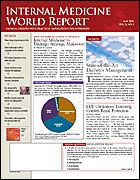Keeping Up with Part D Changes to Meet Patients' Needs
Chief Medical Officer, Centers for Beneficiary Choices, Centers for Medicare & Medicaid Services
More than 30 million Americans have signed up for Medicare Prescription Drug coverage since November 15, 2005. Although the enrollment period closed on May 15, 2006, physicians should be aware of the following details.
Low-Income Subsidy
All your patients who have few financial resources should be informed of the low-income subsidy (LIS), which will continue to be available to help them cover their premiums, copays, and deductibles. The benefit is accessible by calling 800-772-1213 or going to www.ssa.gov/prescriptionhelp. Patients who are approved for LIS will be able to enroll in the Medicare drug benefit (Part D) after the May 15th deadline. Individuals who age into Medicare have 3 months before and 4 months after their birth date to elect a Part D plan. Those who become qualified for Medicaid will receive coverage as a dual eligibility as of their initial date of eligibility notification.
The Appeals Process
We are pleased to announce the availability of an easy way to use the model exception form that has been developed in conjunction with the American Medical Association, America’s Health Insurance Plans, and a number of medical societies and advocacy organizations. This form is needed to start the exceptions and appeals process for patients who wish to get medicines or tier exceptions. The prescriber can go to the provider center at www.cms.hhs.gov/center/provider.asp and download the form to help a patient file an exception in response to a negative coverage decision.
The coverage determination process normally takes 72 hours, unless there is a request for an expedited review because of a medical necessity, in which case the process takes only 24 hours. The Centers for Medicare & Medicaid Services (CMS) sent out a note to all the health plans on April 12, 2006, indicating that the use of this form and prompt attention to these requests are considered a best practice that is an expected standard.
Niacin Now Covered by Part D
Primary care physicians should be aware that after significant consultation with its partner medical societies, CMS has just recently agreed to add to the list of drugs covered under Part D prescriptions for niacin (Niaspan, Niacor) as a treatment for hyperlipidemia. Thus, all Plan D prescription drug plans now have the option of covering these drugs immediately and are expected to notify their enrollees whether they now intend to add 1 or both of these products to their formularies. For contract year 2007 formularies, prescription Niaspan and Niacor should be considered for formulary inclusion similar to all other Part D drugs.
The Part B/D Drugs Problem
CMS is asking assistance from physicians in addressing a drug benefit (Part D) problem. Several drugs have become problematic under Part D, because they also have a role in the treatment of conditions covered under Medicare Part B. For example, prednisone (eg, Meticorten, Deltasone) is frequently used as an immunosuppressive agent after an organ transplant and is paid for under Part B. Because it is also often used for the treatment of minor conditions (eg, poison ivy) in the office setting, it would, therefore, be paid for under the Part D benefit. Another example would be methotrexate (Trexall), which is used for the treatment of breast cancer (payable under Part B) as well as for arthritis (payable under Part D).
Part D drug plans have been requiring that a prior authorization be completed by physicians for drugs payable under both Part B and Part D to ensure that Part D coverage is applicable in the given situation. Such Part B versus Part D prior authorization has added a significant burden on physicians and in many cases has delayed patients from receiving their required medication.
To alleviate this extra burden, CMS has recently instructed Part D plans to allow a prescription for a Part B/D drug to be filled without a prior authorization if a physician writes a “Part D diagnosis” (essentially anything other than cancer or organ transplantation) on the prescription and the words “Part D.”
We would like to verify that health plans are complying with this guidance. If you are being asked to submit a prior authorization on a Part B/D drug under the Part D benefit, even though you indicated a Part D diagnosis and the words “Part D” on the prescription, you could help us correct the situation by sending an e-mail with the name of the drug, the drug plan, the state, and the diagnosis used to: PRIT@cms.hhs.gov. We will follow up by instructing the specific health plan to change its procedure. This request only applies to prior authorizations required for the verification of a Part D versus Part B coverage, and not for prior authorizations required for other purposes.?
Plan D Resources
General questions: www.medicare.gov or 800-MEDICARE (800-633-4227).
Office staff: www.cms.hhs.gov/center/provider.asp
To report a delayed response to a coverage request, e-mail: prit@cms.hhs.gov
